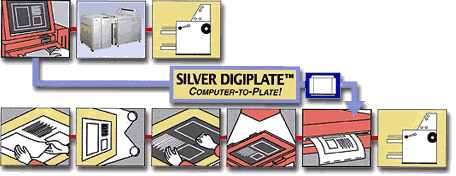~ The use of polyester CTP plates continues to grow, another option for cost savings
At present, the polyester version is still mostly black and white. However, after the printing quality is improved and the number of lines is increased, the polyester version will be suitable for printing color prints. This helps to find a niche in the small color printing market. . Polyester CTP is mostly used in monochrome or bi-color prints, such as invitations, greeting cards, business cards, forms, or letter paper, and has become a low-cost solution for commercial printing and rapid printing.
Economic choice
Polyester version can save working time and cost because it does not need to use negative film. It will become more economical when printing linework, special color or color prints, so polyester version can be considered when doing small-scale printing. In the ten years of development, the polyester version first used the printing of bills, and of course printed commercial forms and documents.
The polyester version is usually associated with monochromatic, two-color, low-quality prints, and the polyester version can now achieve a resolution of 25,000 prints and 175 prints when printed. When printing on the line, people will be amazed at the quality that it can achieve, because the advancement of CTP equipment will enable printers to print higher-quality prints that are not only of the same quality but also of lower cost than metal plates.
Size advantages
The supplier said that more than half of the polyester version is for a small-sized printer or copying machine with a dual-mode size (approximately B4), and the remainder is a four-mode (B3)-size version with a small portion. The copy is an eight-mode (B2) version for printing.
Although the polyester version can be made from plateetters, most of them use imageetters. In fact, from industry surveys (Note: United States), 13% of people with negative film output machines have used output machines to make polyester and paper versions before hearing CTP.
Although there are more negative film output machines on the market than plate type output machines, the negative film output machines are originally designed for use on negative films. When used in printing plates, there are disadvantages in that they cannot be cut or positioned and punched. Some of the new film output machines that have been built in recent years have built-in functions for processing plates, and are another good choice for using polyester plates.
Plates and negatives
Agfa has already designed the Avantra series negative film output machine as a dual-purpose plate and film specification, allowing customers to have CTP capabilities without adding new equipment. One negative film in the output machine holds the negative film and the other film. In the middle of the printing plate, the laser or the printing plate will automatically adjust the laser focal length according to the thickness when it is exposed. It is a dual-purpose output machine.
Polyester plates are available in a variety of sensitivities and are generally classified according to the type of laser used in the output. The most common are infrared and red lasers.
In addition, the printing plate also has a variety of different thicknesses. In general, the larger the area, the thicker it is to keep the plate stable and will not be stretched and deformed when it is on the machine.
Currently, there are only two types of polyester CTP plates on the market, some of which offer their own brands of plates; Kodak said that they have developed a polyester version of the technology but have not yet used them in production.
Last year's (1998) global sales of the polyester version was 136 million pyeong2 (of which 2/3 is analog platemaking), and the aluminum version was more than 700 million pounds 2 which accounted for about 16% of the total.
Seybold exhibited
Agfa introduced the new generation of Setprint Plus polyester version at the recent Saneza show in San Francisco. The new media offers a wider printing range for a variety of small and varied prints, such as black and white printing, special color printing, or color prints. Allows for faster preparation before printing.
At present, Setprint Plus Polyester Edition can withstand printing to 20,000 brushes, outlet performance can be from 5% to 95%, resolution to 150 lines, can print accounting documents, business communications, advertising or promotional brochures.
Setprint Plus Edition is currently available in four thicknesses of 10, 12, 20, and 30 mils. The 12 mils version is suitable for large-size prints. It is easier to handle and does not require additional padding. Can be used in the red laser, red diode laser and helium laser output on the machine, and the version of the child as long as the use of general standard fast stencil machine on it.
New emulsion technology
Mitsubishi DigiPlate can provide more choices when printing, can apply more different ink and flume fluid, and the photosensitivity of the plate is divided into two types of laser (633nm) and red laser (670nm), and the whole is complete. The product line will cover all the spectrum used by the output machine, including 488nm, 633 to 680nm and 780nm.
The plate can withstand up to 25,000 prints with a resolution of 175 lines, and the material in the back sheet of the plate can prevent light from penetrating and increase the ability to handle in the bright room.

â— Comparison of CTP (upper row) and traditional (lower row) plate making processes
Abs Frame Bag Filter,Pre Filter Bag,Pocket Pre Filter,Filter Bag Abs Frame
Ningbo Ifilter Purification Equipment CO.,Ltd. , https://www.nbifiltor.com